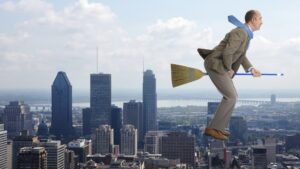MoneyTalks: Bell Potter’s Grady Wulff gives market predictions for the second half, and red flags for tech stocks

Stockhead reached out to Bell Direct's Brady Wulff, who gave her predictions for the second half. Picture Getty
- What will the second half have in store for investors?
- How investors can play geopolitics and recession themes
- Stockhead reached out to Bell Direct’s Grady Wulff, who gave her predictions
There’s been a lot of drama in the first half of 2023, and if you had judged market performance by headlines alone, you might be forgiven for thinking that it’s been a bad year for stocks.
The collapse of US and European banks, the debt ceiling drama, and persistent rate hikes from central banks – just some of the headlines markets had to contend with.
And yet, the S&P 500 is up by 15% so far this year, while the Nasdaq has surged by over 30%.
Back home, the ASX 200 is up with a more modest gain of just 1.5%. The Tech sector has been the hands down winner, up by 28%, while Telcos and Utilities have gained 9% and 7% respectively.
So what’s to come for the second half?
There will definitely be challenges ahead, but signs continue to point to a still-resilient economy.
According to a note from JP Morgan, gains this strong tend to signal the bear market is over.
“In the 21 other instances since 1950 that the S&P 500 has been up at least 10% or more in the first half, it’s rallied further in the second half 17 of those times, with the full year up on average +25%,” said the bank.
Geopolitics to dominate headlines
To see what opportunities H2 may bring for Aussie investors, we reached out to Bell Direct’s market analyst, Grady Wulff.

Wulff believes that geopolitics – the continuing war between Russia and Ukraine and tensions in the Asia Pacific – will be a major theme in the second half.
“Investors are looking at how countries are responding to rising geopolitical tensions, and how their defence spending strategies are going,” Wulff told Stockhead.
“A lot of these countries are reassessing their capabilities and many are looking into AI capabilities.”
That has put companies like ASX-listed DroneShield (ASX:DRO) on the map, says Wulff.
“Some investors believe that investing in war theme stocks actually encourages war, but DroneShield’s technology actually protects lives by taking down autonomous drones that threaten lives.”
Wulff is referring to DroneShield’s AI-powered anti-drone systems that are used to detect and destroy enemy drones or other unmanned aerial vehicles.
“It’s an exciting time for DroneShield, which is one of the opportunities we see in the geopolitical tension area,” she said.
How to play a recession
Other themes to play out in the second half are higher rates and the risk of a recession.
Wulff says that everyone thinks recessions are Doomsday, but they’re actually just temporary pullback in the market.
“Recession is not necessarily something to be scared of. We’ve gone through recessions before, and they’re just a kind of a moderation in the market.”
Over time, markets do come back from recessions, and the good news is that we’re actually weathering and faring through the hardest part right now – which is cost of living pressures that continue to rise.
“As soon as we start to see inflation come down, that’s when we’ll see the Fed and the RBA starting to ease their stance on what’s going on.”
For investors, Wulff said what they need to reconsider in a recession is stocks that can weather the storm and outperform the market.
“Utility stocks like gas, power, electricity, and also telecommunication services – we’re always going to need them so demand won’t fluctuate on price.”
“Consumer staples are another one you can’t live and breathe without, even in a recession,” said Wulff.
Focus on income investing
Wulff says that as interest rates increase, investors are shifting their portfolio towards income assets, ie: stocks that provide a steady dividend.
Income investing is about consistency; in other words, investors must be careful to chose those stocks that pay a consistent and growing dividend.
“It’s really important not to get fooled by companies that are paying a higher dividend in one year, but then no dividends at all the next,” she said.
Wulff says Brickworks (ASX:BKW) is a company that Bell Potter has recently initiated a coverage and has a Buy recommendation on.
“Brickworks has a really good track record of paying dividends, it hasn’t cut dividends since the late 1980s.”
Another dividend stock that Bell Potter likes is shoes retailer Accent Group (ASX:AX1).
“Accent is part of the sector (discretionary) that has been sold off but the company pays growing dividends.”
Accent’s dividend grew from 2.5 cents per share last financial year (FY) to 12.5 cents per share in the first half of this FY.
Artificial intelligence, and red flags for tech stocks
Another major topic that’s driven a lot of the market moves, especially in the US, is artificial intelligence (AI).
“A lot of investors think that investing in technology is just AI, but AI has capabilities and expansion into every sector on the ASX,” Wulff said.
She explained that big miners are investing in AI companies to monitor drilling and enhance their capabilities.
In healthcare, companies are also investing in AI to predict the outcome of clinical trials.
One ASX healthcare company on Bell Potter’s buy list is Telix Pharma (ASX:TLX), which recently acquired an AI company, Dedicaid GmbH, to accelerate its clinical programs.
“It just goes to show that AI is the way to go in 2023 and beyond. Companies that aren’t investing in it are falling behind,” said Wulff.
She warned that when investing in the tech sector, to always remember to consider profitability, AI investment and debt levels before adding the stock to your portfolio.
“Tech companies with high debt levels are falling out of favour with investors this year because rate hikes mean their debts are more expensive to repay,” said Wulff.
“Understand that in the tech space, investors are really wary of investing in companies that have high debt levels, those which have AI tech but aren’t actually sure how to use it, and those that have low annual recurring revenue.”
The views, information, or opinions expressed in the interview in this article are solely those of the interviewee and do not represent the views of Stockhead.
Stockhead has not provided, endorsed or otherwise assumed responsibility for any financial product advice contained in this article.
Related Topics
UNLOCK INSIGHTS
Discover the untold stories of emerging ASX stocks.
Daily news and expert analysis, it's free to subscribe.
By proceeding, you confirm you understand that we handle personal information in accordance with our Privacy Policy.








